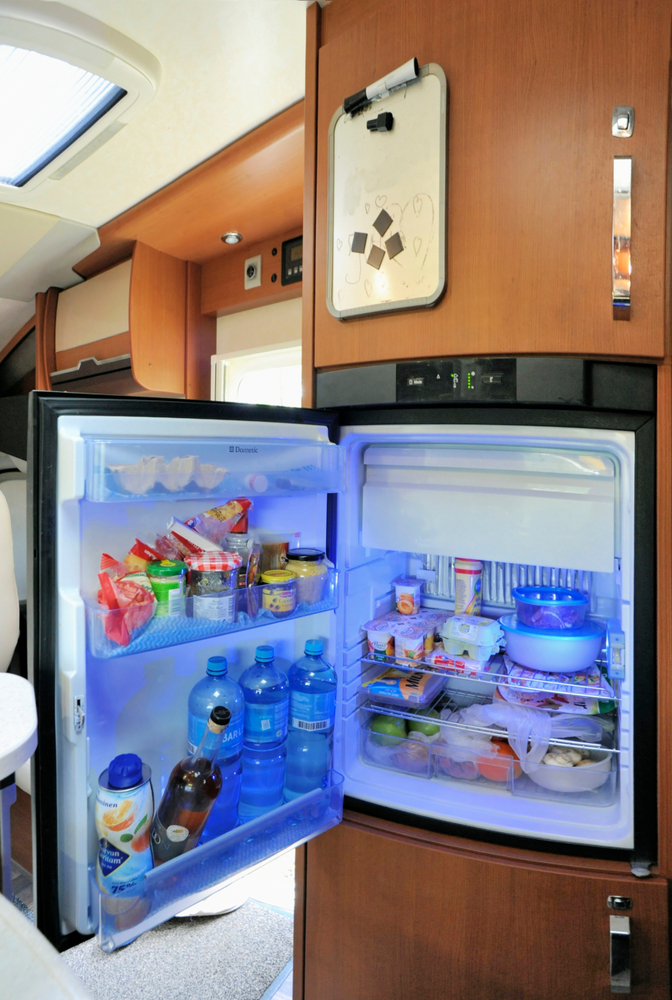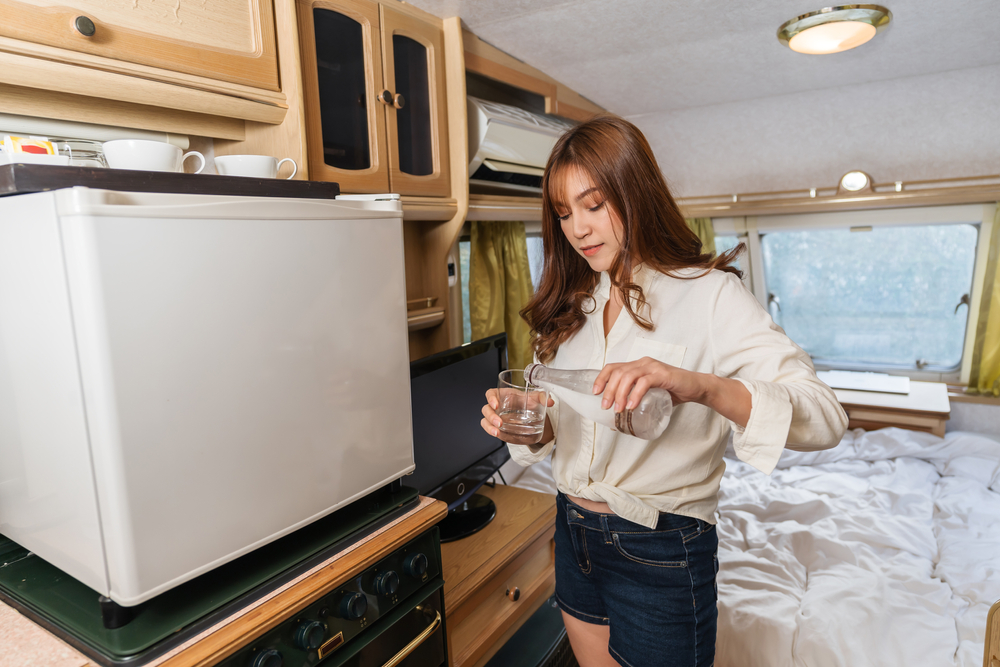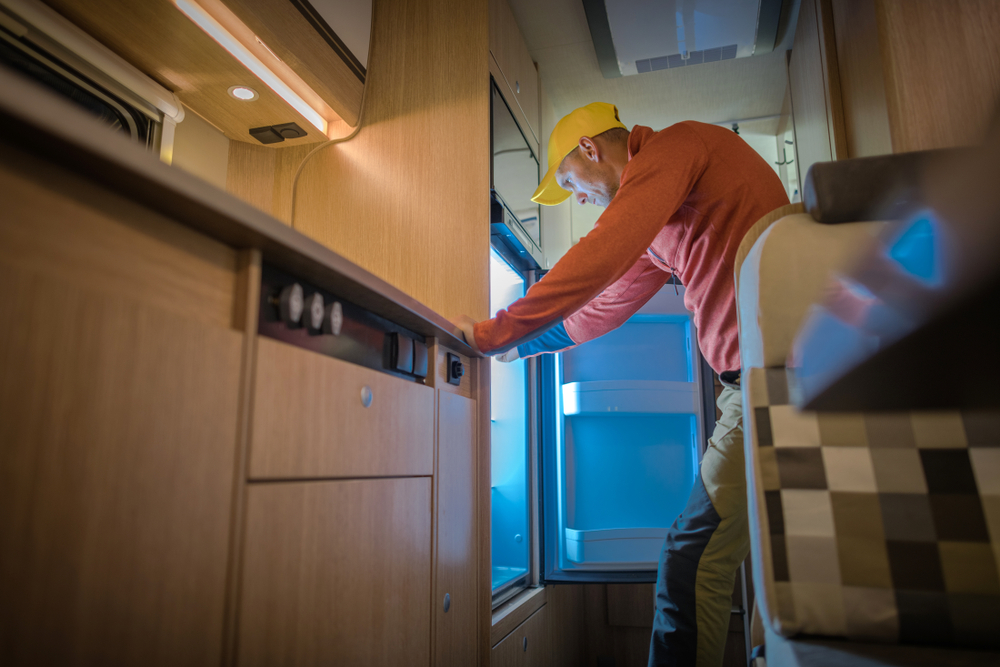
Is your RV refrigerator running? If not, this is the post for you.
Before you call the repair shop why not try to diagnose the problem yourself? Some of the repairs and troubleshooting can actually be done without professional help. In this article, we will discuss the top RV refrigerator problems and troubleshooting tips for how to prevent and fix them.
So don’t throw your fridge out until you try every one of these suggestions. You might just be surprised!
Troubleshooting Tips:
#1- Make Sure it’s Level
The number one RV refrigerator troubleshooting tip is to make sure your rig is completely level. RV refrigerators have liquefied ammonia in the system that works to keep everything cool. The tubing is specifically sloped to continuously move the liquefied ammonia. If it is not level, the circulation will slow and result in a loss of cooling.
The RV needs to be level when parked. Leveling isn’t as important when traveling because the movement will keep the liquid ammonia from accumulating in one area. The absorption design has no mechanical pumps or compressors to circulate the refrigerant in the system, so proper leveling is what maintains the circulation of the refrigerant.
Luckily, to prevent damage to the RV refrigerator cooling units, all you need is a simple tool: a bubble level, which you can get for about $10! Before you park and stabilize your RV, place the level on a shelf in the freezer or refrigerator. Once you are stopped and stable, check the level and make sure that half of the bubble is within the center circle, which indicates the fridge is level.

If the bubble level indicates the RV and RV fridge aren’t level, move the RV from the final stopping point, turn the engine off and set the parking brake. Next, determine how many blocks needed for each tire position and place two stacked blocks against each tire for a configuration like a ramp. Drive the RV up the blocks and stop once you’re at the center of the top blocks. Check your level to make sure everything is now leveled, and make sure the RV is in park, and that the parking brake is on.
#2- Make Sure it’s Properly Vented
The refrigerator needs adequate ventilation to cool properly. Check the air gap between the vent grills, top, and back. A gap should be around these areas. Check the vent grills for dirt and dust. Clean them off. Don’t pack it tight. The refrigerator needs to be able to circulate air in and around the food. If it’s packed tight it won’t cool like it should.
#3- Keep it Cool
The outside temperature will affect how your RV refrigerator is running. If possible, try to park the RV with the refrigerator side in the shade. This will help increase the efficiency of the refrigerator.
#4- Turn it off for storage
Long-term storage can also sometimes cause issues with the operation of your RV refrigerator. Always make sure the fridge is completely turned off before putting your coach in storage for the winter. Close off and disconnect the propane tank valves.
It’s also recommended that you prop open your refrigerator doors and remove any food or ice to prevent moisture from being trapped. No one wants to start their next road trip cleaning a stinky fridge — or fixing one for that matter!
Troubleshooting Techniques

Problem: Pilot Light Won’t Stay Lit
If you own a propane-powered RV fridge, check to see if the pilot light is operational. Check the flame. Is it good? Does it go out right away?
Many times the light won’t stay lit, which may mean you have a bad gas-flow. The flow of propane to the refrigerator is controlled by the thermocouple. First, make sure to clean the flue, burner tube, and the orifice inside the flame area. On the outside of the coach, there is a fridge access. Remove that, along with the tin cover. You may see a rusty build-up or dirt and debris that needs to be cleaned off. Residue can often confuse the sensor, and turn the flame off.
How about now? Then this could be a thermocouple problem. The thermocouple is attached to the main gas valve. You may need to replace it.
Problem: No Cooling Fuel Source
This RV troubleshooting requires several steps. First, remember that most of the components under a fridge are HOT. Be careful, and use gloves when possible. Feel the cooling unit, and make sure that the heat is even in the boiler, absorber and the middle portion of the unit. If it’s not, there may be a blockage, and one area will be much hotter than the others. A blockage means that the cooling liquid is not flowing through the entire unit.
But before you call a professional or spend a lot of money on potential repairs, you may want to move your RV! Believe it or not, if your RV fridge is not cooling the food inside, it could be because of how you are parked. For the refrigerator to work properly, your RV must be level.
When your RV refrigerator is not getting cold, it’s likely not the same type of issue you would find in your fridge at home. This is because most RVs don’t utilize the same kind of refrigerators you may be used to in your home. Instead of using a compressor to cool the items inside your fridge, a fridge in an RV uses gas absorption. Instead of creating cold air like a compressor refrigerator would, in an RV fridge, the heat is drawn out and absorbed by a chemical solution. This solution depends on gravity to travel through the coils, but if the fridge isn’t level, the chemical coolant can’t travel through the coils and cannot do its job, resulting in RV refrigerator problems!
In general, most of the newer RV refrigerators will still be able to function even if they aren’t level, but only for a short period of time. Typically, if a fridge has been not level for over 30 minutes, that is when the RV refrigerator cooling unit can become irreparably damaged. Unfortunately, if the refrigerator has not been level for a significant amount of time, you will likely experience long-term RV refrigerator problems and will either need to rebuild the RV refrigerator cooling unit or purchase a new appliance.
Problem: Leaking Cooling Unit
Let’s say that the boiler is pretty warm and the absorber is very hot. This means there is a leak somewhere. The unit is still working, but the gas is escaping. If you smell ammonia, this confirms the problem.
Also look for yellow residue on the back of the refrigerator. Sodium Chromate is to blame and this means you have a leak. This probably requires a service tech call, which could mean a repair bill or a new RV refrigerator. However, more and more RV owners are choosing to replace the cooling versus replacing the entire fridge. It is up to the individual and what he/she is comfortable with.
Problem: It runs on propane, but not 110v
Check all the circuit breakers and fuses. Check the outlet on the back of the refrigerator. Use a multi-meter to check for power voltage. If the voltage checks out okay and all lights work, then check the electric heating element. Beware this has dangerous voltage.
Problem: Check lights are on
Low voltage could be the cause of this. Coach batteries could be low or dead. The refrigerator has to have 12 volts of power to run on propane, or 120-volt power to run without propane. The coach batteries must be fully charged. Also, try resetting the check-on lights. Do this by powering off, counting to 10, then turning back on again.
Replacing Your RV Refrigerator
Many RV owners are embracing the use of residential refrigerators within their trailers, 5th wheels, and motorhomes. You can usually replace a fridge in less than one hour, whereas rebuilding an old unit could take days. Whatever you decide, be sure to work with an RV technician that is certified in refrigeration repair.
Routine maintenance should be followed to keep the RV refrigerator in good running condition.
It’s a simple process:
- Shut refrigerator off.
- Remove the outside lower vent that allows for back access.
- Check the connections.
- Now locate the burner, the flue is directly above. The baffle is inside the flue. Use an air compressor to blow air into the flue.
- Continue to use the air compressor to remove dust and debris that has built up around the compartment.
Hopefully this article helped you troubleshoot your RV refrigerator, so you can get to the next step in your journey!






